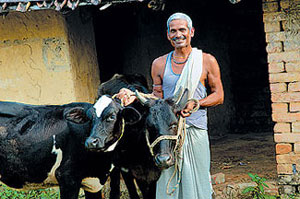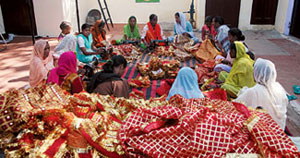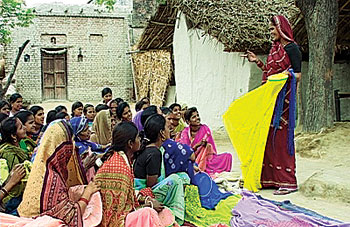 |
Sustainable
Livelihoods |
| The primary focus of
this intervention is to create alternative employment for surplus labour and decrease
pressure on arable land by promoting non-agricultural incomes.
Livestock Development

With the objective of creating high-yielding progenies
through genetic improvement, an additional 40 Cattle Development Centres (CDCs) were
established during 2005-06, taking the total to 72 CDCs covering 1,440 villages. During
the year 27,392 artificial inseminations (AIs) were performed and 35,000 milch animals
were covered under the preventive health programme. |
|
| In some of the project
areas, farmers are being organised into milk marketing societies. These societies will
collect and deliver milk into the milk-routes of existing chilling plants or dairies,
thereby linking the farmers to a formal milk market.
Economic Empowerment of
Women

These programmes aim to create sustainable income
opportunities for women. During the year, 630 self-help groups (SHG) with 10,610 members
mobilised small savings of Rs 35 lakhs. So far 4,398 women have found gainful employment
either through micro-enterprises (2,244) or as self-employed (2,154), availing income
generation loans totalling Rs 74.62 lakhs. |
|

Homemaker to
income-builder
Bhatoura village. Sursa block. Hardoi, Uttar Pradesh.
Rambeti was just another homemaker from a backward group till her friends and neighbours
convinced her to join their self-help group, Shilpika. They even coaxed her to be one of
the office-bearers. Shilpika, with the help of ITC and its partner NGO, worked on a simple
mandate – to upgrade the Chikankari skills of local women and connect them to
markets. Rambeti was instrumental in getting a Master Chikan craftsman to train 50
Shilpika members in the intricacies of the craft that would fetch them far better
remuneration than the Rs 50 to Rs 100 they usually earned for a month of backbreaking
work. As the project gathered momentum, it was evident that the self- help groups needed
'Sanchalikas' – caretakers – for the Chikan production centres. Rambeti was the
natural choice for her group. She began mobilising her team members to work at a faster
pace to meet market deadlines. They also started participating in exhibitions to promote
their products. Today, her group earns a cumulative wage of Rs 70,000 per annum and has
made profits of Rs 52,000. The profit first goes towards repayment of their loans.
Residual profits are shared among the group members. Since the loans are disbursed from a
rotating fund provided by ITC, repayment enables other beneficiaries to participate in
this virtuous cycle. Rambeti has been instrumental in setting up another production group
called Kashida.
Across several states in India, ITC is helping thousands
of women like Rambeti help themselves. |
|
|